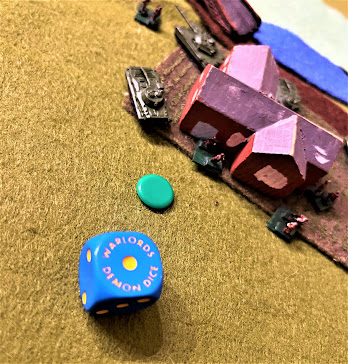My mate Graham spent the 1980s in Germany defying the Soviet threat. He still has a bucket-load of 1/300 West German and Soviet tanks from those days when he was winning the Cold War by playing it out on the tabletop.
We decided to dust them off to explore what is happening in the Ukraine right now. Apologies to any readers who feel current tragic real-world events are not an appropriate subject for a game. This was an exercise in technical curiosity, no political dimension and no bad taste involved. We set up a notional scenario loosely based on the Ukrainian offensive apparently in progress right now just to see how things might go. I say 'loosely' because we had only the sketchiest idea of what the Ukrainian and Russian forces look like and how they operate.
The scenario situation is that three battalions or so of Russians are dug in along a river line, some minor tributary of a larger tributary of the Dnepr. They have only a little armour on-table but a mechanized battalion in reserve. The Ukrainians will probe with three recce companies initially before deciding where to commit their main body.
Reflections:
Just a Game: The first thing to say is that this bore little relation to reality. I just read yesterday that Ukraine is reporting advances of "200 to 500 metres" in fierce fighting, whereas our game of bold armoured manoeuvre produced a relatively swift and easy 3km+. I suppose what is actually happening is more like a WWII infantry assault against prepared defences, with lots of fire support on both sides to pin everyone down, and the Russians apparently conducting "manoeuvre defence" - planned fighting withdrawal through successive defensive lines - rather effectively. Our game was closer to a hastily improvised defence (albeit with trenches): none of the minefields and obstacles that I am sure the Russians have, minimal Russian artillery rather than the considerable support and effective fire plans they evidently have, we underrated the infantry's anti-armour weaponry, the undefended bridge was a highly unlikely fluke, and I played the Russian infantry as essentially passive rather than reacting as intelligently as they seem to be. Also, having read some studies that comment on the effects of drone surveillance and the resulting need for dispersion and mobility, I would have liked to add some scenario special rules to reflect those, but as I last played FFT a decade or so ago and Graham had never used them, that would have been a complication too far. All that said, I suppose our game with its unrealistic and unsuccessful Russian tactics at least partly illustrated why they have opted for the alleged manoeuvre defence instead.
Quality vs quantity: always a good match-up. You could say the game was rigged in that we rated the Russians as "Average" in FFT terms and the Ukrainians as "Good". This quality difference then plays out in both to-hit rolls and saving rolls. This really told once the HEAT and APFSDS started flying.
Lack of practice makes imperfect: although Graham and I are both broadly familiar with the characteristics of the modern kit we were using, how that translates into tabletop interactions using an unfamiliar ruleset is a different story. Our inept fumbling and consequent poor tactics probably made the game even less realistic than it already was.
Get the toys on the table: the gap since my last post betrays the fact that I've gone a few weeks without a game. It was good just to push some models around and roll some dice; doubly so because I rarely get to play a moderns game and some variety in gaming diet is both healthy and refreshing.
Unpredictability makes for interesting games: the semi-random mechanisms for revealing Russian defenders and for arrival of reinforcements worked very well, producing surprises of both pleasant and unpleasant varieties for both sides. While the undefended bridge was improbable in the intended real-world setting, it is by no means without precedent in other real-world situations, and it was great for creating a game narrative and giving both players something unexpected to react to.
Recommendations for future research (as academic papers usually end by saying): Notwithstanding my previous blog post about what dull games frontal assaults usually are, I just might try a more serious version of this, making a proper effort to set up a thoroughly prepared Russian defence - complete with successive defensive lines, obstacles, fireplans and planned withdrawals - and then try to crack it with a similarly well thought-out Ukrainian plan. It would take some effort but that could be justified by the reward.








No comments:
Post a Comment
Comments welcome!